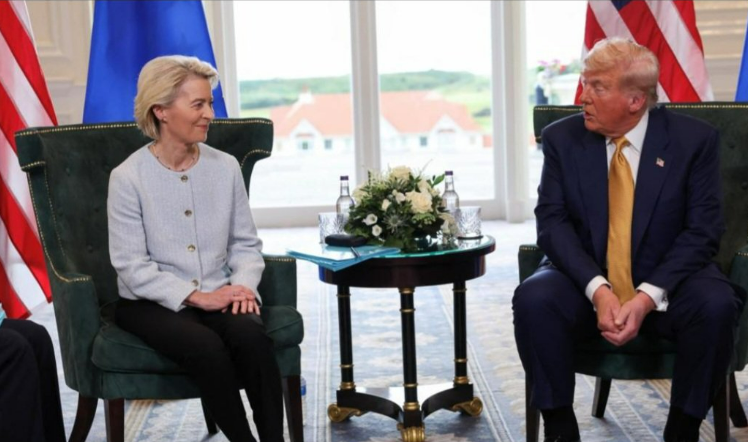July 28 — The United States and the European Union have reached a landmark trade agreement that averts a looming tariff escalation and sets new terms for transatlantic commerce. President Donald Trump and European Commission President Ursula von der Leyen announced the accord after a high-stakes meeting at Trump’s golf resort in Scotland, just days ahead of a planned 30% U.S. tariff hike on European goods.
The newly signed deal introduces a 15% baseline tariff on EU exports to the U.S., encompassing key industries such as automobiles, pharmaceuticals, and semiconductors. In return, the EU has agreed to make significant purchases of American energy and defense products.
Calling it the “biggest-ever” deal of its kind, Trump hailed the agreement as a major win for U.S. economic interests. “We’ve reached a deal. It’s a good deal for everybody,” he said. “This is probably the biggest deal ever reached in any capacity.”
The European Commission confirmed that the EU would buy $750 billion worth of American energy products over three years, including liquefied natural gas, oil, and nuclear fuels. Von der Leyen emphasized that the move is part of the bloc’s strategic push to diversify energy sources and reduce dependence on Russian supplies.
Additionally, the EU committed to $600 billion in new investments tied to U.S. sectors, including military equipment, amid NATO defense commitments.
The agreement also includes selective tariff exemptions on critical sectors, notably aircraft, certain chemicals, raw materials, and specific agricultural goods. Both parties expressed interest in pursuing additional zero-tariff arrangements in the coming weeks, with alcohol products reportedly next in line.
“This agreement brings predictability and stability,” said von der Leyen. “That’s incredibly important for our industries and supply chains on both sides of the Atlantic.”
However, the deal was met with a mixed response across Europe. While German Chancellor Friedrich Merz praised the accord for preventing further deterioration in EU-U.S. trade ties, several industry groups expressed concern about its long-term implications. Germany’s powerful BDI industrial federation warned of “significant negative repercussions,” particularly in manufacturing and chemical exports, while the country’s VCI chemical association noted that tariff levels remain “too high.”
The EU had initially sought exemptions or quota systems, particularly for the automotive and steel sectors, which have been under pressure from previous rounds of U.S. tariffs. While Trump indicated that steel tariffs would remain unchanged, von der Leyen later stated that a quota system for steel imports had been agreed upon, along with future tariff adjustments.
Before this deal, the EU was already facing a 25% U.S. tariff on automobiles, 50% on steel and aluminum, and a 10% general import duty — which the U.S. had threatened to triple in the event of a breakdown in negotiations.
EU member states were briefed remotely during the talks and are expected to formally review the agreement in the coming days. Though the 15% rate is higher than previous averages — which hovered near 5% — leaders said it was preferable to the alternative.
“Fifteen percent is not ideal, but it’s the best outcome under the circumstances,” von der Leyen admitted.
The negotiations concluded with just days to spare before the August 1 deadline Trump had set for new trade pacts or automatic tariff hikes. EU nations had readied retaliatory measures targeting $109 billion worth of U.S. goods, which now appear to be shelved.
With his trademark confidence, Trump labeled the agreement as a cornerstone of his broader campaign to reshape global trade. “This was the big one,” he said. “This is the biggest of them all.”
While the long-term impact remains to be seen, the deal marks a pivotal moment in the ongoing recalibration of U.S.-EU trade dynamics and signals a temporary truce in what had been a steadily intensifying economic standoff.








